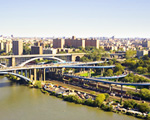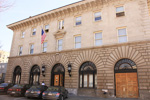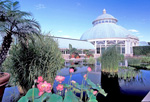The Bronx is generally one of those 'Oh' neighborhoods. You say, 'I live in The Bronx' and people invariably go, 'Oh.' The most audacious even add, 'Is it safe?'.
Generally speaking, the answer is 'yes.'
The Bronx has evolved from the decadent, gang-reigned arson hell it used to be. While the 1970s and 1980s are still engraved in the borough's culture, it is now more famous for being the borough that 'rebuilt itself.'
Jonas Bronck spent only six years in New York, but his influence of the city will go on forever. As first European to settle in what is now The Bronx (back then it was but the south of Westchester County), this Swede was granted the privilege of naming a big river that ran through the northernmost of the area. Little by little, the city annexed the areas west (1874) and east (1895) of the Bronx River.
By 1898, when the borough system was established, northernmost borough was essentially defined by the presence of the Bronx River, so it only seemed logical to name it after him. Hence, it became The Bronx.
Never, ever forget to capitalize the T in it. It's part of its name.

A Forth Apache is how military calls wherever the authorities shelter from hostile enemy (generally native insurrectors, if the many John Ford movies are to be believed.) That name was very famously used in the past for the NYPD's 41st Precinct Station House at 1086 Simpson Street, in the South Bronx. Which gives us a pretty solid idea of how bad that area was. In fact, when Paul Newman starred in an 1981 movie about how futile the police's work was in that area, it was very descriptively called Fort Apache, The Bronx.
But what is more illustrative than the title, is the lawsuit that accompanied the movie's release. Tom Walker must have been very eager to see it, seeing as it coped with the same subject as a novel he had published and it had the exact same title. He sued the film's writer for copyright infringement.
In his own words, 'both the book and the film begin with the murder of a black and a white policeman with a handgun at close range; both depict cockfights, drunks, stripped cars, prostitutes and rats; both show disgruntled, demoralized police officers and unsuccessful foot chases of fleeing criminals'.
The Court of Appeals could not agree with him -- they thought there were only so many ways an indisputable reality could be portrayed. The suit went on to gain notoriety for introducing the concept of scènes à faire to jurisprudence -- the concept of 'scenes that have to be done' to bring a work of art to fruition. If both Fort Apaches aimed to realistically portray The Bronx, those were the scenes they had to include.
Walker lost the case. The South Bronx was that bad. (Although, actually, by the time the film was made, the precinct had actually earned a second nickname, 'Little House on the Prairie,' because two-thirds of the 93,900 people who lived within its boundaries in 1970 had fled.)
In fact, the movie movie consolidated The Bronx as the most dangerous place in America. That's a stretch -- the neighborhood is not that bad -- but if attention is advised in New York, in The Bronx it is compulsory. At least in the South Bronx. The iniquitous, the infamous South Bronx. The neighborhood of the basketball courts, the dealers, the louts, the thugs with elephantiasic biceps, where the attitude lies somewhere between swagger and resignation.

Now, violence is no longer The Bronx's main problem. It does have other problems, though. The six daily meals. The Venezuelan soap opera marathons. The general sense of apathy one inevitably feels as he sets foot on certain neighborhoods of the borough. Social workers complain that The Bronx's youth sit down, watch TV and eat.
Those who put up a fight against their environment and do good, leave. An irreproachable decision, granted. But also one that makes the population come and go all the time, seeking either accommodation or employment. It also leaves the neighborhood bereft of role models.
That's why it's still full of scènes à faire.
It is not easy to leave the South Bronx, though. Mainly because there's no telling where it begins and where it ends. 155 Street offers a guarantee -- it is the line where the pure South Bronx ends and things change a little bit.
The scenery becomes the land of the Bronx Zoo, the New York Botanical Gardens, the New York Yankees, a river called Bronx and about a million and a half people. It also has the next best thing after the now disappeared Little Italy -- Arthur Avenue, which crosses with Belmont. It is a place where people still say hello to each other, where good food is easy to find and it also has the Arthur Avenue Italian Market and the intriguing Ferrade Festival.
The only thing this Bronx shares with the South Bronx is its aspect. Skyscrapers and hope are two parts of the same equation. You remove Manhattan's skyscrapers, its towers, its bridges and what you get is the saddest urban landscape in the world.

The Bronx has no skyscrapers. It does have the heart of many upon many active neighbors, struggling to make their borough a better place. In a way, they have succeeded. The Bronx may not be paradise yet, but it is the very symbol of successful struggle.
As its neighbors put it, 'It's the neighborhood that rebuilt itself'.
Beyond The Bronx, following Broadway in parallel to Broadway, the scene changes. Westchester County starts. With it, a fluvial world of forests, delicate villages, expensive houses, and English-green sights.